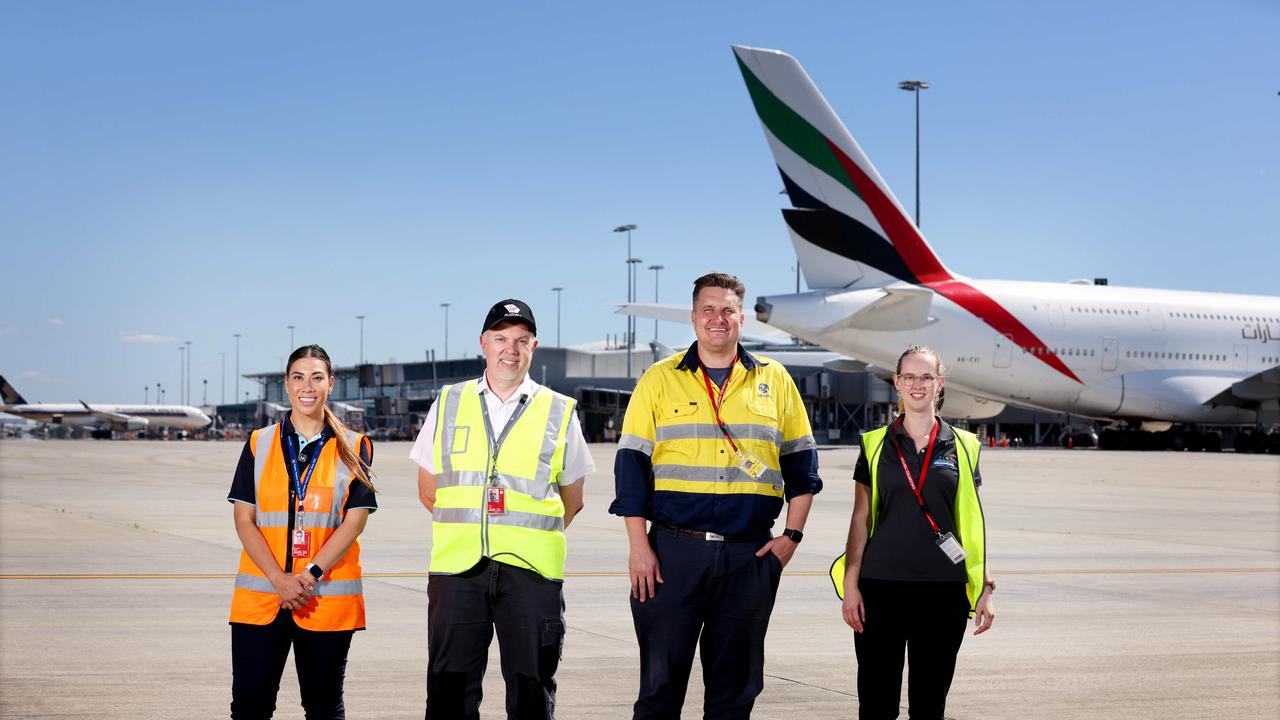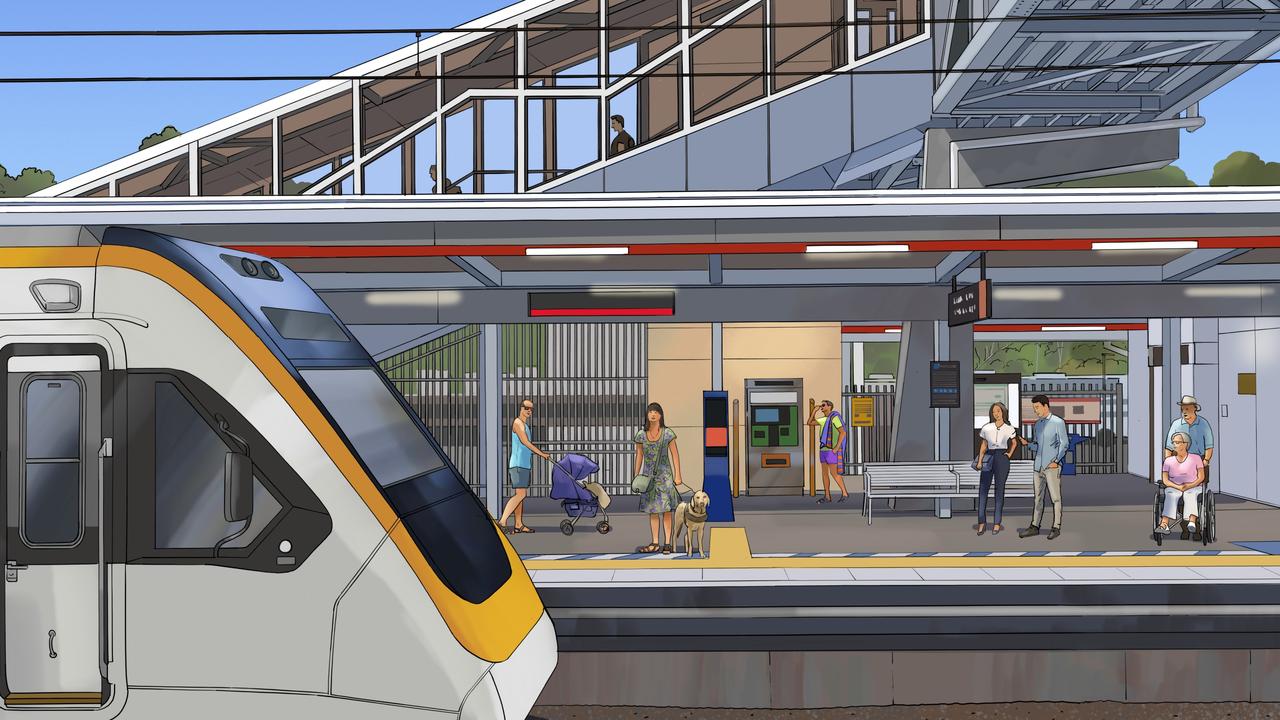Brisbane Airport confirms plan to build new ‘hybrid’ terminal, Airtrain service under review
One of Brisbane’s most important services could be set for change as a review begins that could end a ‘monopoly’. READ THE FULL REPORT

Future QLD
Don't miss out on the headlines from Future QLD. Followed categories will be added to My News.
Brisbane Airport has confirmed planning is underway to build a new hybrid domestic and international terminal as it prepares for a boom in passenger numbers and record infrastructure spending over the next two decades.
It comes amid growing calls to fix the current deal with rail service Airtrain, which is seen as expensive and doesn’t meet the needs of airline passengers and workers across the airport precinct.
SCROLL TO THE BOTTOM TO COMPLETE THE SURVEY AND GIVE US YOUR BRISBANE 2032 IDEAS
The third terminal, to the north of the current domestic terminal, would see BNE become a major connection hub within Australia and a gateway to Asia and North America.
More than $5 billion is being spent over the next 10 years on parking, upgrades to the two existing terminals, a regional aeromedical hub and expansion of Skygate and DFO.
The new terminal would be an additional investment, and will be designed to reduce the time aircraft take to taxi from the runway to the terminal and for passengers connecting to other flights.

Airport bosses are aiming to have the new terminal in place before the 2032 Olympic and Paralympic Games, but the main objective is to cater for projected growth after that time.
The existing two terminals will retain their domestic and international functions.
Brisbane Airport Corporation chief executive Gert-Jan de Graaff said a new terminal was needed.
“The design is not a done deal, but it is highly likely to be between the two runways to minimise taxiing time,” he said.
“The airport has changed a lot since we opened our second runway. It’s highly likely that the new terminal will be between the two runways and not too far off the domestic terminal, so that people who have connecting flights have an easy connection at Brisbane Airport.”
Future Brisbane, in partnership with corporate and community leaders, is exploring the mobility and connectivity legacy priorities ahead of the Brisbane 2032 Games.
While the new terminal would facilitate people moving in and out of the air more efficiently, transport to and from the airport could also be about to change.

Queensland Transport Minister Mark Bailey recently announced the current monopoly arrangement that Airtrain has over public transport to the airport would be reviewed as both the number of passengers travelling through the airport and those working there is set to double over the next 30 years.
Airtrain has been granted a monopoly over transport services to the two existing terminals until 2036, but Mr Bailey said “a lot has changed since the Airtrain was first established in 2001, including substantial population growth, the commissioning of the AirportLink, expansion of parking options at Brisbane Airport terminals”.
“The Department of Transport and Main Roads is in discussions with the operators of the Airtrain service about the future of the service, and its integration with a modern rail network,” he said.
The move follows pressure from both the Brisbane City Council and the airport to review the monopoly in the face of an increase in both tourists travelling through the airport and the number of people working there.

In the last pre-Covid year, 2019, some 24 million passengers transited through Brisbane Airport, but the airport estimates that there will be 50 million going through the airport by 2040 and 60 million by 2050.
Over the same period, the number of people working at the airport is expected to reach 50,000 by 2050, more than double the 24,000 working there now.
This increase will be split between an increase in terminal staff and people working in office, retail or leisure facilities around the current Skygate precinct.
But a major constraint to growth is that the current Airtrain rail service does not stop at the Skygate precinct containing DFO shops, and does not run as regularly as similar services in other cities.
During peak times there is a train leaving the airport every 15 minutes but the rest of the time it is every 30 minutes, compared with Sydney where there is a train leaving the railway station under the airport terminal every 7 minutes.
Mr de Graaff said the airport was very well serviced at the moment by the road network, but this would not be sufficient to cope with airport’s projected future growth.
“It’s very obvious to me that if we want to deliver on that forecast growth, the only way to do that is through better connectivity between the airport and South East Queensland, particularly the Brisbane CBD, the Gold Coast and the Sunshine Coast.
“I cannot build car parks to the end of time, we just don’t have the space for it. So it’s really essential that we develop mass-transport solutions that are fit for purpose, and are meeting the experiences that people can expect when they come to Brisbane.”
The matter is being brought to a head by a proposal from the Brisbane City Council to roll out to the airport its Metro plan, which will come into effect around Brisbane in 2025 and involve a new fleet of electric vehicles running regularly.
Some Metro services will run on existing roads and busways but there will also be new busways built for it, and Brisbane Airport is keen to see this service running to the airport.
Mr de Graaff said that while a Metro service could initially run on the existing road system, there was room at the airport for a dedicated busway line which could accommodate a Metro.
“There are opportunities to create a spine or a very good connection to our terminal precinct for Metro or other services,” he said.
Brisbane Lord Mayor Adrian Schrinner said that extending the network to the airport was “common sense” as it would give residents, visitors and airport workers another travel option.
He said that Airtrain currently costs about five times more than comparable public transport.
“I believe the State needs to consider whether it’s in Brisbane’s best interests for Airtrain’s public transport monopoly to continue, particularly as we now approach the Brisbane 2032 Olympic and Paralympic Games,” he said.
“It also has to be recognised that not only is the occasional Airtrain trip expensive for passengers, it’s simply unaffordable for the 24,000 workers commuting every day to the ever-expanding airport precinct.
“The Metro would be a more affordable public transport option that would also make Brisbane a more attractive option for tourists and benefit the local economy.”
The Queensland Government granted Airtrain the monopoly to provide transport services to the international and domestic terminals when it began operation in 2001, shortly after the airport was privatised by the Federal Government in 1997.





